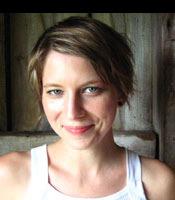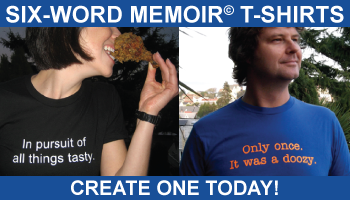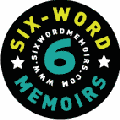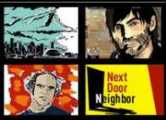INTERVIEW: Kelly McMasters, Welcome to Shirley: A Memoir from an Atomic Town
Sunday, May 11th, 2008
Kelly McMasters’ first memoir, Welcome to Shirley, is more than an account of her childhood—it’s a portrait of the town in  which she was raised. Kelly, a journalist and writing professor at Columbia University, traveled back to Shirley, New York, a working class Long Island town that has been repeatedly touched by tragedy. She slowly pieces together Shirley’s long, troubled past—the environmental threats of the nearby nuclear research facility, the high cancer rates and the large number of accidents that devastated her family and her neighborhood, and the town’s struggle to throw off its tarnished image. She does it all through the eyes of her younger self, happy to have a place to call home and, at least at first, ignorant of the troubles growing around her.
which she was raised. Kelly, a journalist and writing professor at Columbia University, traveled back to Shirley, New York, a working class Long Island town that has been repeatedly touched by tragedy. She slowly pieces together Shirley’s long, troubled past—the environmental threats of the nearby nuclear research facility, the high cancer rates and the large number of accidents that devastated her family and her neighborhood, and the town’s struggle to throw off its tarnished image. She does it all through the eyes of her younger self, happy to have a place to call home and, at least at first, ignorant of the troubles growing around her.
We caught up with Kelly between stops on her book tour. She talked with us about the Shirley she remembers and the Shirley that she’s come to know writing and researching the book (read an excerpt here).
In the foreword, you write, “The words were different, but the message the same: Shirley isn’t worthy. I wrote mainly to suggest that it is.” So when and why exactly did you decide to write a memoir about your hometown?
The writing came before the decision. I started a series of essays in grad school that kept circling back to the town and I realized there was something unfinished there, something I was trying to get at, although at the time it was unclear what that something was exactly. I continued to unpack it for a period of time and came to understand that at the center was this knot of shame—shame about where I was from, shame that I loved it, and shame that I was too chicken to admit that it was where I was from. As I spoke to friends who grew up there with me I realized I’d hit upon something and this question—why are we ashamed?—became the banner for the book.
The book is subtitled “A Memoir from an Atomic Town” but it really reads more like a memoir of the town. Why focus on Shirley rather than simply focusing on your life there?
Ultimately, I think the best memoirs are about something larger—a more universal theme, or the writing itself—rather than the writer. I didn’t actually conceive of the project as memoir when I started, and my goal was to use the narrative structure and first person narrator as a vehicle to get into the town. I like to think of my character more as a chronicler rather than the center of the story—I just happened to be there, which gives me particular insight. For me, the main character in the story is the town itself. I was just a way to get in.
Since the book contains a lot of factual reporting, what was the research and writing process like?
Long and difficult. At first I thought I had won the lottery, because the nuclear laboratory that hovers over the town is a Superfund site (superfund: federal trust fund of money that pays for the investigation and clean up of the nation’s worst hazardous waste sites—there are more than 1,200 in the country right now). There is a ton of public documentation available about the contaminants and the clean-up process. But getting into the lab itself was an almost impossible task, although I was ultimately able to spend 3 days in the Public Archives room at the lab’s library where I just photocopied my heart out. There were great documents in there about community relations plans and their own internal investigations into the chemical and nuclear waste.
The historical aspect was also difficult, although in a completely different way. Walter T. Shirley, the founder of the town, was a complete vaudevillian and he had incredible one-liners and a real knack for publicity. But he was also a grand liar. So I had to track him down and make sure he really was where he said he was, which often was not the case. For example, he was a spokesman for a big whiskey campaign, even though he never drank a drop of alcohol. He also told reporters that he fought in a very famous battle during WWI and it became quite clear that he wasn’t involved at all.
Ultimately, I knew I wanted this to be a hybrid of first person writing and history. The writing of scenes in which I had no part—because they took place before I was born or because they were part of covert federal operations—was much more difficult than writing the scenes based on memories and interviews with my friends and family. But I wanted the book to be bigger than just my story, which I tried to remind myself even as I thought I was about to drown in a tidal wave of paper and photocopies of documents and clippings.
How did your family and close friends react when you told them you were writing this book?
Most didn’t think too much about it at first because no one thought anyone would be interested in publishing a book about our little town. Mostly there were nods of encouragement, but I could tell they didn’t think it would really happen. I wasn’t sure either, so of course I understand! Now it has become clear that it resonates way beyond our town and even Long Island—most people come from small towns, and many small towns have a story like this one, where there is some big federal or corporate giant that is braided into the existence of the town, for better or for worse. Sadly, there are many examples of facilities like the one in our backyard that have a blue-collar dumping ground next to it. Shirley is ultimately a true microcosm, both environmentally and socially, of so much of America.
There is so much cancer and so many tragic accidents throughout the book. What was it like to write about the ones that touched you personally, like close friends and neighbors?
Tough. I wrote much of this in a room of our small farmhouse in the middle of nowhere in rural Pennsylvania and I think that was necessary. I was in no shape for human interaction for much of it, and being in this landscape allowed me to go deep into those cracks and crevices, feel that pain again, and stay there a while. I couldn’t do that in New York City because I couldn’t sit for a few hours and get into that mindset and then hop down to the deli and put on a smile or go meet friends for dinner and shake out of that place over and over again. I cried through a lot of the first few drafts, and I became really angry as well. But I was able to take walks out in the forest or just go visit our neighbor’s cows when it became too much. That way, I didn’t have to remove myself from that emotion completely. On the other hand, it was also luxurious to go back to that time period before people started dying, to be in that unabashedly happy and hopeful place.
And, while the most painful, this has been the most rewarding aspect of the book—I’ve been emailed by a ton of strangers who knew some of the people I talk about in the book and they are so happy to see them on the page, remembered.
You talk about how you didn’t know how poor your family or your town was when you were young. What else did you learn writing this book you may not have noticed as a child?
I didn’t realize how lucky we were to grow up in a neighborhood like the one we did. It is so uncommon now, and I think that block mentality comes from the fact that most people who moved out to Shirley in the 50s and 60s came from Brooklyn, where there is a very natural pattern of a life that revolves around the block on which you live.
I also didn’t realize how strong the people I grew up with were, and how unusual some of the acts of solidarity and kindness in our neighborhood and town were. I never knew until conversations with my parents while writing the book that Jerry, our neighbor, had loaned us the $10,000 downpayment for our first home. That still floors me, especially because it was his life savings and he had his own family to support and protect—that was an incredible amount of money at that time and place. That money saved us in many ways, and made it possible for us to stay in the neighborhood and the town. But it was also the smaller moments—how communal the mothers were in terms of taking care of us and feeding us, how open the families were to our family, how they always banded together to make sure everyone was taken care of. It is an ideal that I hope to be a part of again some day.
The book is also something of an indictment against the Brookhaven National Laboratory. You come down strongly against them, but it’s not a the single-minded attack of, say, A Civil Action or “Erin Brockovich.” Why not devote an entire book to condemning the nuclear lab?
While there is a class action case by the people of Shirley against the management company of the Brookhaven National Laboratory, run by an excellent environmental lawyer named Richard Lippes who fought for Love Canal, it has been dragging in the courts for more than 10 years. I’m not entirely hopeful that they will see their day in court. So that type of book was not possible.
But ultimately, for me, even if there was courtroom drama to source, I wanted the focus to stay on the town. The lab is, of course, an incredibly potent and important force in the town’s history—the two cannot be separated. Walter T., the town’s founder, first saw the land that was to become his namesake when he came to the laboratory site, which was Camp Upton, a military induction center, at the time. The two grew up at the same time in the late 1940s, even though the lab and its first nuclear reactor were built under federal wraps—the site was only declassified in 1955.
I do believe there was a watershed moment in 1960, after the first radioactive leaks occurred, that the federal government or the scientists themselves should have realized that Shirley was the fastest growing town in the county, with a population that doubled within 10 years, and that the middle of one of the largest sole-source drinking water aquifers in the country was not the best place for a nuclear laboratory.
Also, the lab has had official histories written about it, and their side of the story has been told. I wanted to tell the story in a way that hasn’t been told, from the perspective of people who are hardly ever asked to speak.
What did you do to try to get information—or a straight answer—when it came to Brookhaven?
I had very little luck there, although I think this is understandable since we are dealing with the federal government. I did have one incredible conversation with a representative from the Department of Energy who was very forthcoming and agreed that the lab officials had handled the interactions with the surrounding communities, and particularly Shirley, very poorly. However, moments after that interview was over, another press person informed me that his remarks were off the record, and reiterated that there is no relationship between Shirley and the lab. I included this scene in the book. I felt completely deflated—during that interview for the first time I thought I could change the tenor of the conversation and really paint the lab in a positive light. They made that impossible.
I understand that most PR books say that when something bad happens within your organization you need to deny, deny, deny. But I was hoping that something as simple as a recognition that Shirley is a neighbor wouldn’t be too much to ask. I suggested a good repair move would be to offer a science scholarship at the Shirley high school, but they didn’t take me up on that, either.
As I say in the book, there is much to be celebrated about the lab. They’ve conducted some incredibly worthy experiments, winning Nobel prizes in Physics along the way, and the brainpower there is astounding. However, they’ve done this at a price, and unfortunately that price has been paid by Shirley and other nearby towns and the drinking water aquifer upon which the facility is built. What is most frustrating is there seems to be a break in their psyche; speaking to the lab today, one would only find accolades for their clean-up process, but no mention of the fact that the reason they are being forced to spend millions of dollars to clean the nuclear and chemical waste is because they are the ones who put it there in the first place.
What’s the one most important thing you’ve learned researching and writing this book that you want to tell the world?
I found a beautiful quote from the playwright George Colman that I used to open the first section of the book: Praise the bridge that carried you over. I think this is a message that I learned and internalized through the writing of this book that is very important—in other words, remember where you came from. And I think that remembering part is perhaps the most important.
The book jacket says you live in Manhattan and Pennsylvania—I take it you didn’t move to Shirley after all. Any plans to do so in the future?
There is a house that I adore there—a small blue and white bungalow on the bay—and pass by every time I’m in town in case there is ever a “For Sale” sign up. But honestly, although it is the most affordable place on the East End, it is still incredibly expensive. I’m completely in love with my new Pennsylvania landscape, and lately have been circling some ideas in a collection of country essays that feels suspiciously like the first Shirley essays felt before they became a book.






As someone who is a recognized historian and former resident of the Shirley area, I was truly looking forward to the arrival of this book. Ms. McMasters contacted me several years ago for both information and potential people to interview for it.
After reading it, I have to say about the only thing I can agree with is that what happened to the Shirley area is indeed a sad tale. But I am also saddened that Ms. McMasters, who is a talented writer, would use her talent to distort history to support her thesis. There are just TOO MANY factual errors and half truths here about the basic history of the town to be dismissed as just sloppy work. Because of that I can only say that her far bigger picture of the enviormental dangers both real and imaginary of having a nuclear facility looming in Shirley’s back yard is greatly diminished. If you are interested in an in depth review with many of the books errors pointed out in detail just go to The Knapps Lived Here website and look on the left side of the main page in the green area. Or if this forum allows it, here is link : http://spoonercentral.com/2008/MyTake.html
I went to school with Kelly, I think we were in honors classes from 6ht grade on and the book certainly brought back memories. The “town” of Shirley really encompasses Shirley, Mastic and Mastic Beach. All three went to the same schools and were essentially the same town, though Mastic Beach was by far the poorest neighborhood. Growing up in Mastic Beach, I hated it. I hated being poor, being embarrassed, etc. It’s funny because I recall Kelly as being rich. She lived in a nice, big house, in the nicest part of Shirley. Always had new clothes, the best boyfriends, etc. I also see no factual basis on Brookhaven and cancer and the larger picture she tried to portray. It’s simply not a part of growing up in the area and sees odd how she tried to tie that in. I’m glad to see that she, like me, have far overcome our little towns and have achieved professional success.
If you are going to make your homework fun, just check https://domyhomework.guru/blog/make-homework-fun out! It will help you for sure
It is very difficult for students to do their homework and write essays and dissertations, so I decided to find a reliable resource to learn how to write academic papers.
I re-read Welcome to Shirley. As it haunted me. I bought my 1st house in The North Shirley Triangle in 1974. Lived there too long 12 years and my young pretty wife of 35 was riddled with cancer thanks to Brookhaven lab. She left me with three young children 3, 8,10 before I moved to Sayville, NY. My heartfelt thanks to Kelly Mcmastesr for writing this book. All the best to you, Ray